![]()
![]()
![]()
Use LEFT and RIGHT arrow keys to navigate between flashcards;
Use UP and DOWN arrow keys to flip the card;
H to show hint;
A reads text to speech;
32 Cards in this Set
- Front
- Back
|
What is a blister? (explain the MOA)
|
Blister is a bubble like space which arises when there is a separation of the the different layers of skin
|
|
|
Pemphigus Vulgaris
Pathogenesis? (MOA) |
Autoimmune destruction of desmosomes between keratinocytes
|
|
|
What kind of antibodies are made in Pemphigus vulgaris? Against what structure in the skin?
|
IgG antibody against the desmosomes (desmoglein = the specific name)
|
|
|
What type of hypersensitivty reaction is pemphigus vulgaris?
|
Type II
(AB mediated cytotoxic via membrane attack complex) |
|
|
What is the typical involvment (body part) in pemphigus vulgaris?**
What kind of lesions are formed (note: use derm terminology) |
Skin and oral mucosa
Bullae (>1cm and fluid filled) |
|
|
What are keratinocytes connected by?
|
Desmosomes
(AB formed against that in Pemphigus vulgaris) |
|
|
What is Acantholysis?
In what disease does this happen? |
Seperation b/w cells (keratinocytes) b/c desmosomes destroyed
happens in pemphigus vulgaris |
|
|
What layer of the epidermis is the separation formed in pemphigus vulgaris?
|
Since it is the separation b/w keratinocytes, it seperates the basal layer from the rest of the epidermis
The basal layer keratinocytes are attached to basement membrane via hemidesmosomes (NOT desmosomes) |
|
|
Nikolsky sign?
|
The thin walled bullae rupture easily.
When you touch them, their skin easily scrapes off Pemphigus Vulgaris |
|
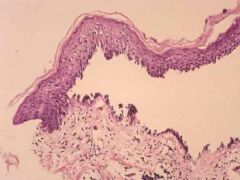
What disease is this?
|
This is pemphigus vulgaris b/c the basal layer still attached
Tombstone appearance (basal layer) |
|
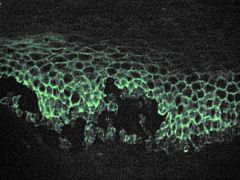
Immunofluorescence highlighting IgG. What kind of pattern is this?
Associated with what disease? |
Fishnet pattern
Immunofluorescence highlights IgG surrounding the keratinocytes in a fishnet pattern Pemphigus vulgaris |
|
|
Bullous Pemphigoid
MOA of disease |
autoimmune destruction of hemidesmosomes b/w basal cells and basement membrane
|
|
|
Bullous pemphigoid
What kind of antibodies are produced? Against what? |
IgG antibody against basement membrane collagen
|
|
|
What are the common locations to see blisters?
|
Skin ONLY
(no oral; helps differentiate from pemphigus vulgaris) |
|
|
How do you differentiate b/w Bullous pemphigoid and pemphigus vulgaris?
(clinically and histology) |
BP:
histology - subepidermis blister clinical - do not rupture easily (milder) PV: histology: suprabasal blister clinically: rupture easily (Nikolsky sign) |
|
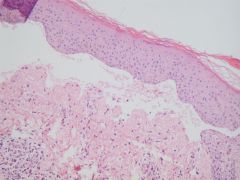
What is this?
|
Bullous pemphigoid
|
|
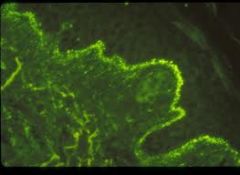
Immunofluorescence highlights IgG
|
IgG along basement membrane
Linear pattern Bullous pemphigoid |
|

24 yr old male pt. comes in with lesions on his forearm. When you touch them they don't rupture easily. What does he likely have?
|
These are blisters (fluid filled; >1cm)
Bullous Pemphigoid |
|
|
Dermatitis Herpetiformis
MOA of disease |
Autoimmune deposition of IgA at the tips of dermal papillae
|
|
|
What is contained in the dermal papillae
|
many things but blood vessels probably most vulnerable to injury
|
|
|
What kind of skin lesions do you get with Dermatitis Herpetiformis
|
vesicles (fluid filled <1cm) and bullae (fluid filled >1cm) that are grouped
ITHCY note: looks like herpes, hence the name |
|
|
What is Dermatitis Herpetiformis associated with?****
|
Strong associated with Celiac Disease
resolves with gluten free diet (both) |
|
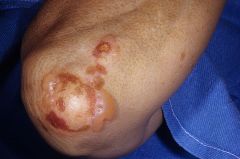
|
Dermatitis herpetiformis
grouped fluid filled vessicles/bullae Itchy |
|
|
Erythema multiforme
MOA of disease |
hypersensitivty reaction characterized by TARGET rash and bullae
|
|
|
Why do you get targetoid appearance in Erythema multiforme?
|
Central epidermal necrosis leads to the center being white
|
|
|
What is the most common associated with Erythema Multiforme?
Other associations? |
Most common: HSV infections
Others: Mycoplasma infection, drugs (eg. penicillin), autoimmune diseases, malignancy |
|

|
Erythema multiforme
|
|
|
Stevens-Johnson syndrome
|
EM (target rash) WITH
-mucosa/lip involvment -Fever |
|
|
Toxic epidermal necrolysis
|
Severe form of Steven-johnson syndrome characterized by sloughing of skin, resembling a large burn.
Medical emergency |
|
|
What is the toxic epidermal necrolysis most often due to?
What is it a severe form of? |
most often due to drugs
severe form of Steven Johnson syndrome |
|
|
What are the common places to lesions for pemphigus vulgaris?**
|
Skin and Oral mucosa bullae
|
|
|
What is Dermatitis Herpetiformis assocaited with?**
|
Celiac disease
|

